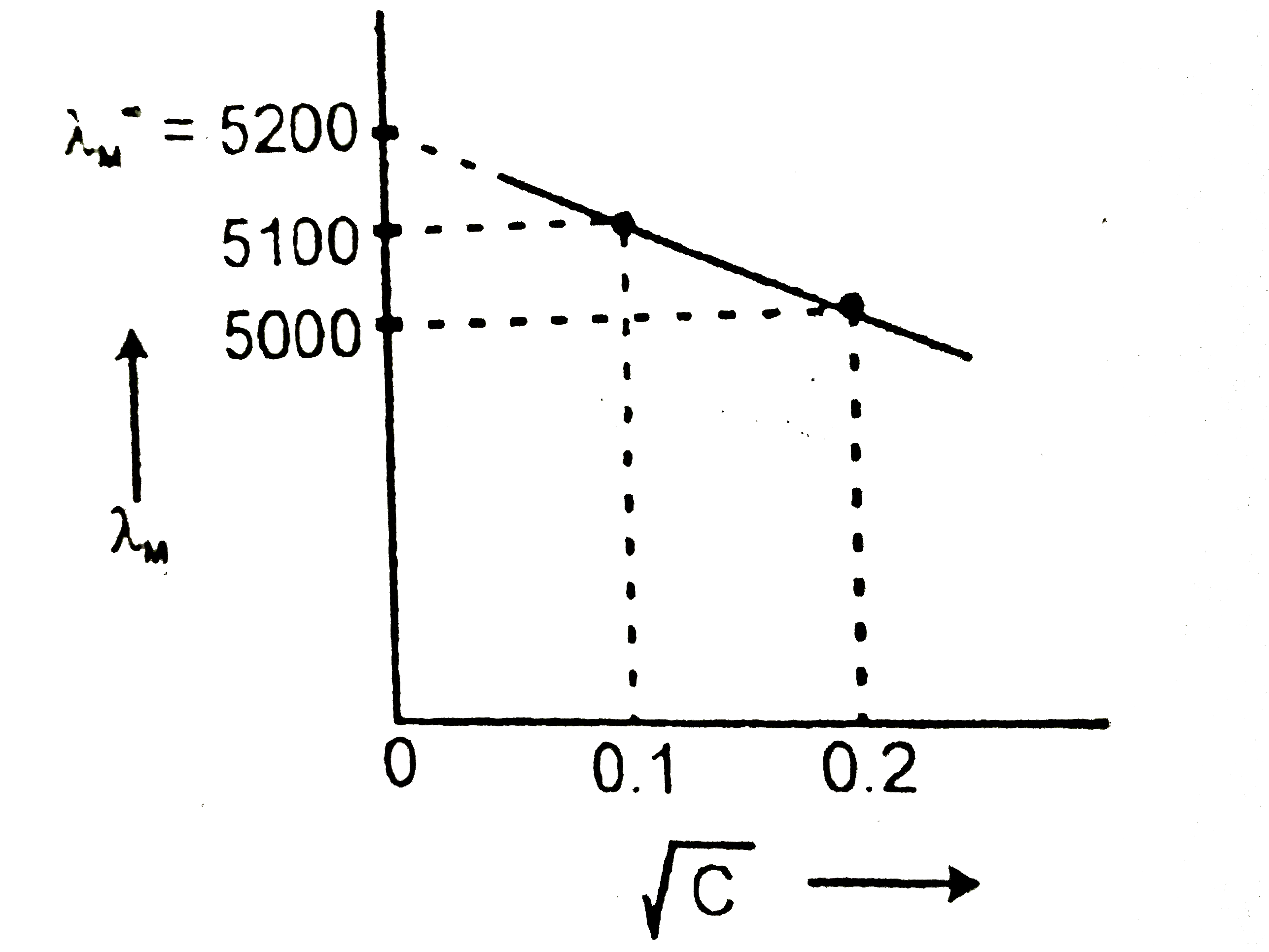Definie conductivity and molar conductivity for the solution of an electrolyte. Discuss their variation with concentration.
The reciprocal of resistivity is known as specific conductance or simply conductivity. It is denoted by K (Kappa).
K=1PorK=G×1a
Hence, conductivity of a solution is defined as the conductance of a conductor of 1 cm length and having 1 sq. cm as the area of cross section. Alternatively, it may be defined as conductance of one centimtre cube of the solution of the electrolyte. Molar conductivity of a solution at a dilution V is the conductance of all the ions produced from 1 mole of the electrolyte dissolved in Vcm3 of the ions produced by ∧m
∧m=KV
Variation of conductivity and molar conductivity with concentration: Conductivity always decreases with decrease in concentration, for both weak and strong electrolytes. Because the number of ions per unit volume that carry the current in a solution decreases on dilution.
Molar conductivity vs for acetic acid (weak electrolyte) and potassium Chloride (strong electrolyte) in aqueous solutions Molar conductivity increases with decrease in concentration. Because that total volume, V, of solution containing one mole of electrolyte also increases. It has been found that decrease in on dilution of a solution is more than compensated by increase in its volume.

Topper's Solved these Questions
- ELECTROCHEMISTRYBOOK - VMC MODULES ENGLISHCHAPTER - ELECTROCHEMISTRYEXERCISE - Level- 0 (Short Answer Type - II ) (3Marks)
10 Videos
- ELECTROCHEMISTRYBOOK - VMC MODULES ENGLISHCHAPTER - ELECTROCHEMISTRYEXERCISE - Level-0 (Long Answer Type ) (5 Marks)
1 Video
- ELECTROCHEMISTRYBOOK - VMC MODULES ENGLISHCHAPTER - ELECTROCHEMISTRYEXERCISE - Level-0 (Very short Answer Type )(1Marks)
1 Video
- CLASSIFICATION OF ELEMENTS AND PERIODICITY IN PROPERTIES BOOK - VMC MODULES ENGLISHCHAPTER - CLASSIFICATION OF ELEMENTS AND PERIODICITY IN PROPERTIES EXERCISE - JEE ADVANCE (ARCHIVE)
30 Videos
- ENVIRONMENTAL CHEMISTRYBOOK - VMC MODULES ENGLISHCHAPTER - ENVIRONMENTAL CHEMISTRYEXERCISE - JEE Main (Archive)
39 Videos
Similar Questions
Define conductivity and molar conductivity for the solution of an electrolyte. Discuss their variation with concentration.
View Solution(a) Define the terms conductivity and molar conductivity for the solution of an electrolyte.
Comment on their variation with temperature
(b) The measured resistance of a conductance cell was 100 ohms. Calculate (i) the specific conductance and (ii) the molar conductance of the solution
(KCl=74.5gmol−1 and cell constant =1.25 cm−1)
View Solution
Knowledge Check
Limiting molar conductivity of NaBr is
AΛ∘mNaBr=Λ∘mNaCl+Λ∘mKBrBΛ∘mNaBr=Λ∘mNaCl+Λ∘mKBr−Λ∘mKClCΛ∘mNaBr=Λ∘mNaOH+Λ∘mNaBr−Λ∘mNaClDΛ∘mNaBr=Λ∘mNaCl−Λ∘mNaBr
Define molar conductance
View SolutionExpress the relation between.conductivity and molar conductivity of a solution.
View SolutionResistivity is reciprocal of molar conductivity of electrolyte.
View SolutionThe molar conductivity of strong electrolyte
View Solution(a) Apply Kohlrausch law of independent migration of ions, write the expression to determine the limiting molar conductivity of calcium chloride.
(b) Given are the conductivity and molar conductivity of NaCI solutions at 298 K at different concentrations :

Compare the variation of conductivity and molar conductivity of NaCI solutions on dilution. Give reason.
(c) 0.1 M KCI solution offered a resistance of 100 ohms in conductivity cell at 298 K. If the cell constant of the cell is 1.29cm−1, calculate the molar conductivity of KCI solution.
View Solution
At 0.04 M concentration the molar conductivity of a solution of a electrolyte is 5000Ω−1cm2mol−1 while at 0.01 M concentration the value is 5100Ω−1cm2mol−1 making necessary assumption (taking it as strong electrolyte) find the molar conductivity at infinite dilution and also determine the degree of dissociation of strong electrolyte at 0.04M.
View SolutionAt 0.04 M concentration, the molar conductivity of solution of an electrolyte is 5000Ω−1cm2mol−1 while at 0.01 M concentration the value is 5100Ω−1cm2mol−1. Making necessary assumption (Taking it as strong electrolyte) find the molar conductivity at infinite dilution and write percentage dissociation of strong electrolyte at 0.04 M.
View Solution